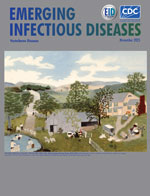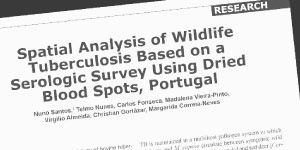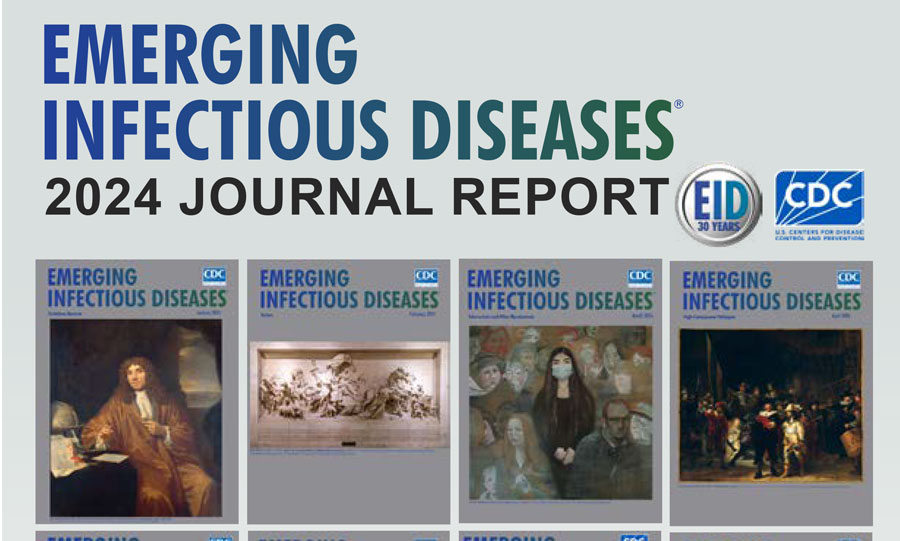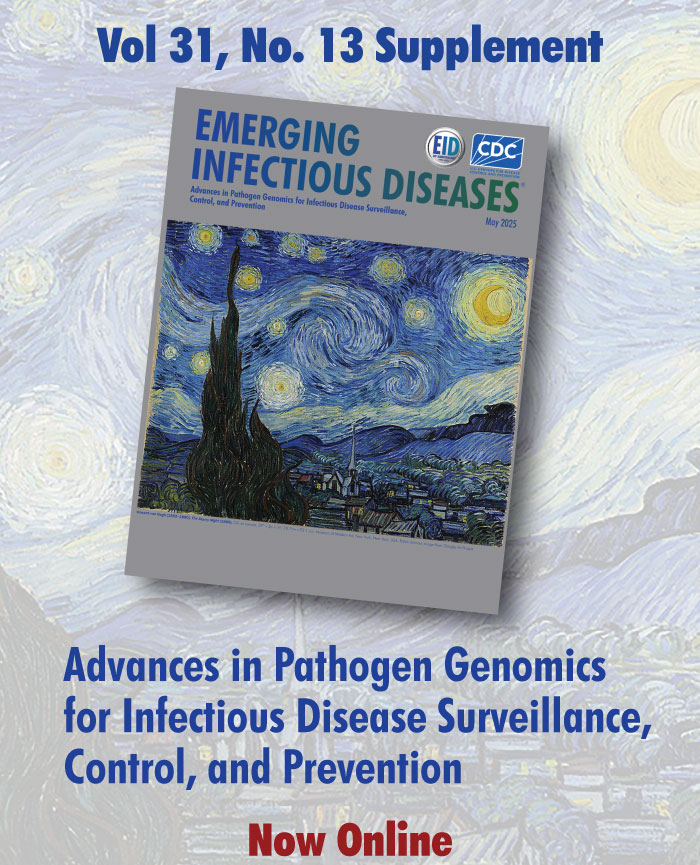Articles from Emerging Infectious Diseases
Volume 31, Number 11—November 2025
Synopses
Haematospirillum jordaniae was first identified as a human pathogen in 2016. In this article, we describe 4 patients who had H. jordaniae infections identified in 2020 and who had temporally and spatially linked environmental exposures. Three of the 4 patients reported leg injuries while participating in recreational river water activities in south-central Pennsylvania, USA. In 2024, we detected H. jordaniae in river samples collected at locations identified during patient interviews. All patients sought emergency department services for clinical assessment; however, the causative bacterial isolate was not initially identified. H. jordaniae was identified as the bacterial cause months after patient treatment and discharge. Although H. jordaniae infections are considered rare, the true occurrence is unknown. Additional information about the organism’s ecology and environmental seasonality could guide public health messaging and increase awareness among healthcare providers.
| EID | Dulcey M, DeBord KM, Bell ME, Murray MT, Szewc AM, Livingston K, et al. Haematospirillum jordaniae Infections after Recreational Exposure to River Water, Pennsylvania, USA, 2020. Emerg Infect Dis. 2025;31(11):2073-2079. https://doi.org/10.3201/eid3111.241586 |
|---|---|
| AMA | Dulcey M, DeBord KM, Bell ME, et al. Haematospirillum jordaniae Infections after Recreational Exposure to River Water, Pennsylvania, USA, 2020. Emerging Infectious Diseases. 2025;31(11):2073-2079. doi:10.3201/eid3111.241586. |
| APA | Dulcey, M., DeBord, K. M., Bell, M. E., Murray, M. T., Szewc, A. M., Livingston, K....Bower, W. A. (2025). Haematospirillum jordaniae Infections after Recreational Exposure to River Water, Pennsylvania, USA, 2020. Emerging Infectious Diseases, 31(11), 2073-2079. https://doi.org/10.3201/eid3111.241586. |
Trichosporon austroamericanum Infections among Hospitalized Patients, France, 2022–2024
During 2022–2024, six cases of invasive fungal infection occurred among immunocompromised patients at Marseille University Hospital, Marseille, France. Matrix-assisted laser desorption/ionization time-of-flight mass spectrometry initially identified Trichosporon inkin fungi. However, phylogenetic analysis of intergenic spacer region 1 and whole-genome sequences revealed the genetically distinct species T. austroamericanum. Analysis of core genome and mitogenome from 6 patient isolates and 1 environmental isolate revealed substantial genetic diversity among T. austroamericanum strains, indicating a polyclonal outbreak. Furthermore, the mitochondrial genome emerged as a potential marker for intraspecies differentiation, which potentially could aid in epidemiologic investigations. Identified in 2024 but potentially underestimated, T. austroamericanum has since been reported in case clusters from hospital settings in France, highlighting the need for accurate fungal identification and suggesting previously identified T. inkin cases should be re-evaluated for T. austroamericanum. Clinical T. austroamericanum is emerging in hospital settings and should be included in the differential diagnosis of fungal infections.
| EID | Burel E, Sartor C, Moal V, Bossi V, Sevestre J, Solignac J, et al. Trichosporon austroamericanum Infections among Hospitalized Patients, France, 2022–2024. Emerg Infect Dis. 2025;31(11):2080-2090. https://doi.org/10.3201/eid3111.250503 |
|---|---|
| AMA | Burel E, Sartor C, Moal V, et al. Trichosporon austroamericanum Infections among Hospitalized Patients, France, 2022–2024. Emerging Infectious Diseases. 2025;31(11):2080-2090. doi:10.3201/eid3111.250503. |
| APA | Burel, E., Sartor, C., Moal, V., Bossi, V., Sevestre, J., Solignac, J....Menu, E. (2025). Trichosporon austroamericanum Infections among Hospitalized Patients, France, 2022–2024. Emerging Infectious Diseases, 31(11), 2080-2090. https://doi.org/10.3201/eid3111.250503. |
Research
Tickborne Neoehrlichia mikurensis in the Blood of Blood Donors, Norway, 2023
The tickborne bacterial pathogen Neoehrlichia mikurensis has been detected in <1% of blood donors in Sweden. N. mikurensis can give rise to asymptomatic persistent infections. Up to 25% of Ixodes ricinus ticks in southern Norway are infected with N. mikurensis. We investigated the incidence of N. mikurensis infection among blood donors in this region. We detected N. mikurensis in the blood of 45/499 (9%) blood donors by independent PCR methods; 69% of those were repeatedly positive 1–7 months after the first detection and tested negative after doxycycline treatment. We tested 8/19 adult recipients of potentially infected blood; none tested positive for N. mikurensis at the time of testing (191–301 days after transfusion). Our study identified a very high rate of infection with N. mikurensis in blood donors in Norway; whether infection can be transmitted by transfusion of blood products, however, remains unclear.
| EID | Quarsten H, Ryen C, Mørk L, Wennerås C, Steinsvåg CT. Tickborne Neoehrlichia mikurensis in the Blood of Blood Donors, Norway, 2023. Emerg Infect Dis. 2025;31(11):2091-2097. https://doi.org/10.3201/eid3111.250125 |
|---|---|
| AMA | Quarsten H, Ryen C, Mørk L, et al. Tickborne Neoehrlichia mikurensis in the Blood of Blood Donors, Norway, 2023. Emerging Infectious Diseases. 2025;31(11):2091-2097. doi:10.3201/eid3111.250125. |
| APA | Quarsten, H., Ryen, C., Mørk, L., Wennerås, C., & Steinsvåg, C. T. (2025). Tickborne Neoehrlichia mikurensis in the Blood of Blood Donors, Norway, 2023. Emerging Infectious Diseases, 31(11), 2091-2097. https://doi.org/10.3201/eid3111.250125. |
Two Independent Acquisitions of Multidrug Resistance Gene lsaC in Streptococcus pneumoniae Serotype 20 Multilocus Sequence Type 1257
Among >25,000 invasive pneumococcal disease isolates recovered in US locations during 2015–early 2024 through population-based surveillance, we detected 17 case isolates carrying the lsaC gene, which has been shown to confer resistance to clindamycin in group B Streptococcus. Sixteen isolates carried the mef, msrD, tetM, and lsaC genes on a 29-kb mobile element acquired through an interspecies recombination event and were intermediately clindamycin resistant. One isolate acquired a 62-kb mobile element containing the ermB, tetM, and lsaC genes through a transposition event. All 17 cases were in adults, including 4 adults experiencing homelessness and 9 with substance abuse problems. All 17 lsaC-positive isolates shared a 5.2-kb lsaC-containing element precisely integrated within the conserved oriT site of their respective mobile element. Those 17 lsaC-positive strains were all serotype 20, multilocus sequence type 1257, and were recovered recently (2021–2024); isolates 1–16 represented emergent disease clusters in New York and Connecticut.
| EID | Beall B, Lin W, Li Z, Tran T, Metcalf BJ, Anderson BJ, et al. Two Independent Acquisitions of Multidrug Resistance Gene lsaC in Streptococcus pneumoniae Serotype 20 Multilocus Sequence Type 1257. Emerg Infect Dis. 2025;31(11):2098-2108. https://doi.org/10.3201/eid3111.251101 |
|---|---|
| AMA | Beall B, Lin W, Li Z, et al. Two Independent Acquisitions of Multidrug Resistance Gene lsaC in Streptococcus pneumoniae Serotype 20 Multilocus Sequence Type 1257. Emerging Infectious Diseases. 2025;31(11):2098-2108. doi:10.3201/eid3111.251101. |
| APA | Beall, B., Lin, W., Li, Z., Tran, T., Metcalf, B. J., Anderson, B. J....Chochua, S. (2025). Two Independent Acquisitions of Multidrug Resistance Gene lsaC in Streptococcus pneumoniae Serotype 20 Multilocus Sequence Type 1257. Emerging Infectious Diseases, 31(11), 2098-2108. https://doi.org/10.3201/eid3111.251101. |
Community-Driven, Text Message–Based COVID-19 Surveillance System, Los Angeles County, California, USA, 2020–2024
Respiratory virus indicators were unreliable at the onset of the COVID-19 pandemic when testing availability was limited and residents with mild symptoms were advised to avoid unnecessary medical care. The Los Angeles County Department of Public Health (Los Angeles, California, USA) developed Angelenos in Action (AiA), a text message–based community syndromic surveillance system to monitor respiratory illness trends. Approximately 17,000 unique participants responded >1 time; 43% of participants continue to regularly respond to the survey. We assessed AiA’s performance by measuring correlation coefficients with reported COVID-19 case counts (0.975), sentinel laboratory SARS-CoV-2 test positivity rate (0.762), and wastewater SARS-CoV-2 concentrations (0.861). AiA performed strongly against 3 comparator surveillance methods and correlated particularly well with raw case counts. A moderate correlation was also noted between influenza test positivity rate and AiA data, indicating the system has potential to detect respiratory illness besides COVID-19.
| EID | Braunfeld JB, Traub E, Chiou H, Amoon AT, Collins C, Joyce A, et al. Community-Driven, Text Message–Based COVID-19 Surveillance System, Los Angeles County, California, USA, 2020–2024. Emerg Infect Dis. 2025;31(11):2109-2117. https://doi.org/10.3201/eid3111.250907 |
|---|---|
| AMA | Braunfeld JB, Traub E, Chiou H, et al. Community-Driven, Text Message–Based COVID-19 Surveillance System, Los Angeles County, California, USA, 2020–2024. Emerging Infectious Diseases. 2025;31(11):2109-2117. doi:10.3201/eid3111.250907. |
| APA | Braunfeld, J. B., Traub, E., Chiou, H., Amoon, A. T., Collins, C., Joyce, A....de St. Maurice, A. (2025). Community-Driven, Text Message–Based COVID-19 Surveillance System, Los Angeles County, California, USA, 2020–2024. Emerging Infectious Diseases, 31(11), 2109-2117. https://doi.org/10.3201/eid3111.250907. |
Isolation and Characterization of Rickettsia finnyi, Novel Pathogenic Spotted Fever Group Rickettsia in Dogs, United States
In 2020, a novel spotted fever group Rickettsia was described in 3 clinically ill dogs in the United States. Using naturally infected canine blood, the novel Rickettsia sp. was isolated in epithelial (Vero E6) and mononuclear (DH82 and 030D) cell lines. The sequenced whole genome revealed a 1.27 Mb circular chromosome with 96.87% identity to Rickettsia raoultii on the basis of average nucleotide identity analysis. A maximum-likelihood phylogeny tree placed the novel Rickettsia in its own branch within the spotted fever group. Immunofluorescence revealed single rods localized along the membrane in epithelial cells and randomly distributed in the cytoplasm of mononuclear cells. We propose the name Rickettsia finnyi sp. nov., strain 2024-CO-Wats, which is available from national and international Rickettsial isolate reference collections. Fever and thrombocytopenia were among abnormalities in the 17 naturally infected dogs we describe, underscoring the pathogenic importance of R. finnyi sp. nov. and its potential public health relevance.
| EID | Korla PK, Karounos MG, Clarke SB, Robveille C, Wilson JM, Breitschwerdt EB, et al. Isolation and Characterization of Rickettsia finnyi, Novel Pathogenic Spotted Fever Group Rickettsia in Dogs, United States. Emerg Infect Dis. 2025;31(11):2118-2127. https://doi.org/10.3201/eid3111.250681 |
|---|---|
| AMA | Korla PK, Karounos MG, Clarke SB, et al. Isolation and Characterization of Rickettsia finnyi, Novel Pathogenic Spotted Fever Group Rickettsia in Dogs, United States. Emerging Infectious Diseases. 2025;31(11):2118-2127. doi:10.3201/eid3111.250681. |
| APA | Korla, P. K., Karounos, M. G., Clarke, S. B., Robveille, C., Wilson, J. M., Breitschwerdt, E. B....Qurollo, B. A. (2025). Isolation and Characterization of Rickettsia finnyi, Novel Pathogenic Spotted Fever Group Rickettsia in Dogs, United States. Emerging Infectious Diseases, 31(11), 2118-2127. https://doi.org/10.3201/eid3111.250681. |
Monkeypox Virus Partial-Genome Amplicon Sequencing for Improvement of Genomic Surveillance during Mpox Outbreaks
Mpox is a reemerging infectious disease caused by monkeypox virus (MPXV). Whole-genome sequencing provides comprehensive surveillance of MPXV but is challenging in resource-limited outbreak settings and on clinical samples with low viral load. We developed a low-cost, high-throughput partial-genome sequencing strategy and a freeware Nextflow pipeline for MPXV genomic surveillance. We targeted 2 genomic regions of MPXV by using short overlapping amplicons. This amplicon-based approach generated high-quality sequences over the 2 genomic regions from clinical specimens, including samples with low viral DNA and from formalin-fixed tissues. This partial-genome sequencing approach can determine MPXV subclades and offers an attractive strategy to lower cost and improve MPXV surveillance during outbreaks in mpox-endemic and -nonendemic countries.
| EID | Deng J, McGrath D, Wilkins K, Haddock LA, Davidson W, Rabeneck DB, et al. Monkeypox Virus Partial-Genome Amplicon Sequencing for Improvement of Genomic Surveillance during Mpox Outbreaks. Emerg Infect Dis. 2025;31(11):2128-2137. https://doi.org/10.3201/eid3111.250548 |
|---|---|
| AMA | Deng J, McGrath D, Wilkins K, et al. Monkeypox Virus Partial-Genome Amplicon Sequencing for Improvement of Genomic Surveillance during Mpox Outbreaks. Emerging Infectious Diseases. 2025;31(11):2128-2137. doi:10.3201/eid3111.250548. |
| APA | Deng, J., McGrath, D., Wilkins, K., Haddock, L. A., Davidson, W., Rabeneck, D. B....Gigante, C. (2025). Monkeypox Virus Partial-Genome Amplicon Sequencing for Improvement of Genomic Surveillance during Mpox Outbreaks. Emerging Infectious Diseases, 31(11), 2128-2137. https://doi.org/10.3201/eid3111.250548. |
Dispatches
Bjerkandera spp. Pulmonary Infection in Immunocompromised Hosts, Germany
We report 3 cases of probable invasive pulmonary disease caused by Bjerkandera spp. fungi in immunocompromised patients in Germany. Accurate identification required internal transcribed spacer sequencing. Response to antifungal treatment varied. Our report underlines the pathogenic potential of Bjerkandera spp. and the importance of molecular diagnostics in rare fungal infections.
| EID | Sprute R, Seidel D, Mehler K, Westhues Z, Butzer SK, Stemler J, et al. Bjerkandera spp. Pulmonary Infection in Immunocompromised Hosts, Germany. Emerg Infect Dis. 2025;31(11):2138-2142. https://doi.org/10.3201/eid3111.250878 |
|---|---|
| AMA | Sprute R, Seidel D, Mehler K, et al. Bjerkandera spp. Pulmonary Infection in Immunocompromised Hosts, Germany. Emerging Infectious Diseases. 2025;31(11):2138-2142. doi:10.3201/eid3111.250878. |
| APA | Sprute, R., Seidel, D., Mehler, K., Westhues, Z., Butzer, S. K., Stemler, J....Koehler, P. (2025). Bjerkandera spp. Pulmonary Infection in Immunocompromised Hosts, Germany. Emerging Infectious Diseases, 31(11), 2138-2142. https://doi.org/10.3201/eid3111.250878. |
Novel Dolphin Tupavirus from Stranded Atlantic White-Sided Dolphin with Severe Encephalitis, Canada, 2024
We sequenced a novel rhabdovirus, Tupavirus delphini (dolphin tupavirus), from the brain of a stranded dead Atlantic white-sided dolphin with severe encephalitis in Canada. In situ hybridization linked presence of the virus to the animal’s brain pathology and death. Our findings underscore the importance of monitoring marine mammals for unexpected pathogens.
| EID | Vernygora O, Bourque L, Jones M, Nielsen O, Embury-Hyatt C, Moffat E, et al. Novel Dolphin Tupavirus from Stranded Atlantic White-Sided Dolphin with Severe Encephalitis, Canada, 2024. Emerg Infect Dis. 2025;31(11):2144-2148. https://doi.org/10.3201/eid3111.251203 |
|---|---|
| AMA | Vernygora O, Bourque L, Jones M, et al. Novel Dolphin Tupavirus from Stranded Atlantic White-Sided Dolphin with Severe Encephalitis, Canada, 2024. Emerging Infectious Diseases. 2025;31(11):2144-2148. doi:10.3201/eid3111.251203. |
| APA | Vernygora, O., Bourque, L., Jones, M., Nielsen, O., Embury-Hyatt, C., Moffat, E....Lung, O. (2025). Novel Dolphin Tupavirus from Stranded Atlantic White-Sided Dolphin with Severe Encephalitis, Canada, 2024. Emerging Infectious Diseases, 31(11), 2144-2148. https://doi.org/10.3201/eid3111.251203. |
Neoehrlichia mikurensis in Ticks and Tick-Bitten Persons, Sweden and Finland, 2008–2009
By using PCR testing, we found Neoehrlichia mikurensis DNA in 1.1% of ticks removed from persons in Sweden and Finland. Symptoms developed in 2 immunocompetent persons. Despite low transmission risk, infection can occur after short tick attachment. Our findings highlight the need to consider N. mikurensis in patients with unexplained symptoms after tick bite.
| EID | Hero E, Lager M, Forsberg P, Lindgren P, Henningsson AJ, Wilhelmsson P. Neoehrlichia mikurensis in Ticks and Tick-Bitten Persons, Sweden and Finland, 2008–2009. Emerg Infect Dis. 2025;31(11):2149-2152. https://doi.org/10.3201/eid3111.241850 |
|---|---|
| AMA | Hero E, Lager M, Forsberg P, et al. Neoehrlichia mikurensis in Ticks and Tick-Bitten Persons, Sweden and Finland, 2008–2009. Emerging Infectious Diseases. 2025;31(11):2149-2152. doi:10.3201/eid3111.241850. |
| APA | Hero, E., Lager, M., Forsberg, P., Lindgren, P., Henningsson, A. J., & Wilhelmsson, P. (2025). Neoehrlichia mikurensis in Ticks and Tick-Bitten Persons, Sweden and Finland, 2008–2009. Emerging Infectious Diseases, 31(11), 2149-2152. https://doi.org/10.3201/eid3111.241850. |
Shifting Dynamics of Dengue Virus Serotype 2 and Emergence of Cosmopolitan Genotype, Costa Rica, 2024
Dengue remains a major public health challenge. In Costa Rica, we implemented nationwide genomic surveillance to track dengue virus serotype 2 cosmopolitan genotype emergence. Phylogenetic and eco-epidemiologic analyses revealed early detection, climate-driven spread, and spatial heterogeneity. Our findings underscore the need for integrated surveillance to guide adaptive responses to emerging arboviral threats.
| EID | González-Elizondo M, Soto D, Laurent E, Martínez F, Alcantara L, Fonseca V, et al. Shifting Dynamics of Dengue Virus Serotype 2 and Emergence of Cosmopolitan Genotype, Costa Rica, 2024. Emerg Infect Dis. 2025;31(11):2153-2158. https://doi.org/10.3201/eid3111.250746 |
|---|---|
| AMA | González-Elizondo M, Soto D, Laurent E, et al. Shifting Dynamics of Dengue Virus Serotype 2 and Emergence of Cosmopolitan Genotype, Costa Rica, 2024. Emerging Infectious Diseases. 2025;31(11):2153-2158. doi:10.3201/eid3111.250746. |
| APA | González-Elizondo, M., Soto, D., Laurent, E., Martínez, F., Alcantara, L., Fonseca, V....Garita, C. (2025). Shifting Dynamics of Dengue Virus Serotype 2 and Emergence of Cosmopolitan Genotype, Costa Rica, 2024. Emerging Infectious Diseases, 31(11), 2153-2158. https://doi.org/10.3201/eid3111.250746. |
Spiroplasma ixodetis in Ticks Removed from Humans, Sweden and Åland Islands, Finland
The prevalence of Spiroplasma ixodetis in ticks that have bitten humans in Sweden and in the Åland Islands, Finland, was 2.6%, with observed significant geographic differences between regions. The pathogen was not detected in blood samples from participants bitten by S. ixodetis–positive ticks, indicating low risk for transmission to humans.
| EID | Lager M, Alkattan Y, Karlsson A, Fernström L, Grankvist A, Wennerås C, et al. Spiroplasma ixodetis in Ticks Removed from Humans, Sweden and Åland Islands, Finland. Emerg Infect Dis. 2025;31(11):2159-2162. https://doi.org/10.3201/eid3111.250545 |
|---|---|
| AMA | Lager M, Alkattan Y, Karlsson A, et al. Spiroplasma ixodetis in Ticks Removed from Humans, Sweden and Åland Islands, Finland. Emerging Infectious Diseases. 2025;31(11):2159-2162. doi:10.3201/eid3111.250545. |
| APA | Lager, M., Alkattan, Y., Karlsson, A., Fernström, L., Grankvist, A., Wennerås, C....Henningsson, A. J. (2025). Spiroplasma ixodetis in Ticks Removed from Humans, Sweden and Åland Islands, Finland. Emerging Infectious Diseases, 31(11), 2159-2162. https://doi.org/10.3201/eid3111.250545. |
Two Autochthonous Cases of Anaplasmosis, Washington, USA, 2022–2023
We describe 2 cases of autochthonous human anaplasmosis in Washington, USA, where anaplasmosis has been rarely reported. Clinicians should consider anaplasmosis in the differential diagnosis for patients with compatible clinical symptoms after tick bite or time spent outdoors in an area where Ixodes pacificus ticks are present.
| EID | Schnitzler H, Chan M, Nybo J, Palmer-McGee K, Doobovsky Z, Tracy I, et al. Two Autochthonous Cases of Anaplasmosis, Washington, USA, 2022–2023. Emerg Infect Dis. 2025;31(11):2163-2166. https://doi.org/10.3201/eid3111.250379 |
|---|---|
| AMA | Schnitzler H, Chan M, Nybo J, et al. Two Autochthonous Cases of Anaplasmosis, Washington, USA, 2022–2023. Emerging Infectious Diseases. 2025;31(11):2163-2166. doi:10.3201/eid3111.250379. |
| APA | Schnitzler, H., Chan, M., Nybo, J., Palmer-McGee, K., Doobovsky, Z., Tracy, I....Oltean, H. N. (2025). Two Autochthonous Cases of Anaplasmosis, Washington, USA, 2022–2023. Emerging Infectious Diseases, 31(11), 2163-2166. https://doi.org/10.3201/eid3111.250379. |
Borrelia afzelii Hepatitis in Patient Treated with Venetoclax and Obinutuzumab, Switzerland
We report Borrelia afzelii hepatitis in an immunosuppressed patient in Switzerland receiving anti-CD20 therapy and venetoclax. Diagnosis was made by metagenomic sequencing and PCR. This case underscores the need to consider Lyme borreliosis in unexplained hepatitis cases and highlights the value of molecular diagnostics in immunosuppressed patients when serologic test results are negative.
| EID | Capoferri G, Battegay R, Hamelin B, Keller PM, Mertz KD, Weisser M. Borrelia afzelii Hepatitis in Patient Treated with Venetoclax and Obinutuzumab, Switzerland. Emerg Infect Dis. 2025;31(11):2167-2171. https://doi.org/10.3201/eid3111.250584 |
|---|---|
| AMA | Capoferri G, Battegay R, Hamelin B, et al. Borrelia afzelii Hepatitis in Patient Treated with Venetoclax and Obinutuzumab, Switzerland. Emerging Infectious Diseases. 2025;31(11):2167-2171. doi:10.3201/eid3111.250584. |
| APA | Capoferri, G., Battegay, R., Hamelin, B., Keller, P. M., Mertz, K. D., & Weisser, M. (2025). Borrelia afzelii Hepatitis in Patient Treated with Venetoclax and Obinutuzumab, Switzerland. Emerging Infectious Diseases, 31(11), 2167-2171. https://doi.org/10.3201/eid3111.250584. |
Research Letters
Two Cases of Autochthonous West Nile Virus Encephalitis, Paris, France, 2025
We report 2 cases of febrile lymphocytic meningitis with encephalitis in patients in France. One patient had not traveled outside Paris; the other had traveled to eastern France. Laboratory findings revealed acute West Nile virus infection. The cases occurred days apart, raising concern the virus has spread further in France.
| EID | Hassold-Rugolino N, Jaquet P, Da Silva D, Papa E, Calmettes J, Henry C, et al. Two Cases of Autochthonous West Nile Virus Encephalitis, Paris, France, 2025. Emerg Infect Dis. 2025;31(11):2172-2174. https://doi.org/10.3201/eid3111.251220 |
|---|---|
| AMA | Hassold-Rugolino N, Jaquet P, Da Silva D, et al. Two Cases of Autochthonous West Nile Virus Encephalitis, Paris, France, 2025. Emerging Infectious Diseases. 2025;31(11):2172-2174. doi:10.3201/eid3111.251220. |
| APA | Hassold-Rugolino, N., Jaquet, P., Da Silva, D., Papa, E., Calmettes, J., Henry, C....Tandjaoui-Lambiotte, Y. (2025). Two Cases of Autochthonous West Nile Virus Encephalitis, Paris, France, 2025. Emerging Infectious Diseases, 31(11), 2172-2174. https://doi.org/10.3201/eid3111.251220. |
Human Infection with Avian Influenza A(H10N3) Virus, China, 2024
We describe the clinical symptoms and epidemiologic characteristics of a patient infected with avian influenza A(H10N3) virus in Guangxi Province, China, in December 2024. Whole-genome sequencing showed that the virus was highly homologous to a virus from Yunnan Province. H10 subtype viruses should be monitored for potential zoonotic or reassortant events.
| EID | Wang J, Bi F, Luo X, Huang H, Liang C, Zhao Y, et al. Human Infection with Avian Influenza A(H10N3) Virus, China, 2024. Emerg Infect Dis. 2025;31(11):2174-2176. https://doi.org/10.3201/eid3111.250847 |
|---|---|
| AMA | Wang J, Bi F, Luo X, et al. Human Infection with Avian Influenza A(H10N3) Virus, China, 2024. Emerging Infectious Diseases. 2025;31(11):2174-2176. doi:10.3201/eid3111.250847. |
| APA | Wang, J., Bi, F., Luo, X., Huang, H., Liang, C., Zhao, Y....Lan, G. (2025). Human Infection with Avian Influenza A(H10N3) Virus, China, 2024. Emerging Infectious Diseases, 31(11), 2174-2176. https://doi.org/10.3201/eid3111.250847. |
Detection of Aedes (Fredwardsius) vittatus Mosquitoes, Yucatán Peninsula, Mexico, 2025
We report detection of Aedes (Fredwardsius) vittatus mosquitoes in continental North America, in Yucatán, Mexico. Phylogenetic analysis clustered the sequence from mosquitoes collected in Mexico with Caribbean mosquito lineages, suggesting species introduction via the Caribbean. Given its arbovirus competence, urgent inclusion of the Ae. vittatus mosquito in surveillance programs is warranted.
| EID | Chan-Chable RJ, Rodríguez-Luna CR, Espinal-Palomino R, Ibarra-Cerdeña CN. Detection of Aedes (Fredwardsius) vittatus Mosquitoes, Yucatán Peninsula, Mexico, 2025. Emerg Infect Dis. 2025;31(11):2177-2179. https://doi.org/10.3201/eid3111.251358 |
|---|---|
| AMA | Chan-Chable RJ, Rodríguez-Luna CR, Espinal-Palomino R, et al. Detection of Aedes (Fredwardsius) vittatus Mosquitoes, Yucatán Peninsula, Mexico, 2025. Emerging Infectious Diseases. 2025;31(11):2177-2179. doi:10.3201/eid3111.251358. |
| APA | Chan-Chable, R. J., Rodríguez-Luna, C. R., Espinal-Palomino, R., & Ibarra-Cerdeña, C. N. (2025). Detection of Aedes (Fredwardsius) vittatus Mosquitoes, Yucatán Peninsula, Mexico, 2025. Emerging Infectious Diseases, 31(11), 2177-2179. https://doi.org/10.3201/eid3111.251358. |
Fatal Tick-Borne Encephalitis in Unvaccinated Traveler from the United States to Switzerland, 2022
We report an unvaccinated traveler from the United States who contracted fulminant fatal tick-borne encephalitis while visiting Switzerland. Climate changes and international travel are intensifying tick exposure for unvaccinated persons. The increasing incidence of tick-borne encephalitis across Europe underscores the importance of tick bite prevention and vaccination against tick-borne encephalitis virus.
| EID | Scotti C, Greub G, Ahmad Y, Burgermeister S, Di Liberto G, Hewer E, et al. Fatal Tick-Borne Encephalitis in Unvaccinated Traveler from the United States to Switzerland, 2022. Emerg Infect Dis. 2025;31(11):2180-2181. https://doi.org/10.3201/eid3111.251320 |
|---|---|
| AMA | Scotti C, Greub G, Ahmad Y, et al. Fatal Tick-Borne Encephalitis in Unvaccinated Traveler from the United States to Switzerland, 2022. Emerging Infectious Diseases. 2025;31(11):2180-2181. doi:10.3201/eid3111.251320. |
| APA | Scotti, C., Greub, G., Ahmad, Y., Burgermeister, S., Di Liberto, G., Hewer, E....Pantet, O. (2025). Fatal Tick-Borne Encephalitis in Unvaccinated Traveler from the United States to Switzerland, 2022. Emerging Infectious Diseases, 31(11), 2180-2181. https://doi.org/10.3201/eid3111.251320. |
Crimean-Congo Hemorrhagic Fever Virus in Cattle and Ticks, Israel
We conducted a nationwide serologic and molecular survey to elucidate the epidemiologic status of Crimean-Congo hemorrhagic fever virus in Israel. We found serologic and molecular evidence of virus circulation in the country. Future human cases could be prevented by increasing public awareness and implementing public health measures.
| EID | Rudoler N, Rubinstein-Guini M, Roth A, Indenbaum V, Erster O, Lustig Y, et al. Crimean-Congo Hemorrhagic Fever Virus in Cattle and Ticks, Israel. Emerg Infect Dis. 2025;31(11):2182-2185. https://doi.org/10.3201/eid3111.250622 |
|---|---|
| AMA | Rudoler N, Rubinstein-Guini M, Roth A, et al. Crimean-Congo Hemorrhagic Fever Virus in Cattle and Ticks, Israel. Emerging Infectious Diseases. 2025;31(11):2182-2185. doi:10.3201/eid3111.250622. |
| APA | Rudoler, N., Rubinstein-Guini, M., Roth, A., Indenbaum, V., Erster, O., Lustig, Y....Eliahoo, E. (2025). Crimean-Congo Hemorrhagic Fever Virus in Cattle and Ticks, Israel. Emerging Infectious Diseases, 31(11), 2182-2185. https://doi.org/10.3201/eid3111.250622. |
Extensively Drug-Resistant Tuberculosis with Conflicting Resistance Testing Results, Lesotho
A patient with extensively drug-resistant tuberculosis in Lesotho recovered successfully after failed treatment with bedaquiline, delamanid, linezolid, and clofazimine. Whole-genome sequencing and broth microdilution testing results were not in agreement, illustrating the urgent need for studies that correlate phenotypic and genotypic resistance testing with clinical response.
| EID | Seung KJ, Asfaw M, Kunda M, Maama-Maime L, Makaka J, Mofolo M, et al. Extensively Drug-Resistant Tuberculosis with Conflicting Resistance Testing Results, Lesotho. Emerg Infect Dis. 2025;31(11):2185-2187. https://doi.org/10.3201/eid3111.250885 |
|---|---|
| AMA | Seung KJ, Asfaw M, Kunda M, et al. Extensively Drug-Resistant Tuberculosis with Conflicting Resistance Testing Results, Lesotho. Emerging Infectious Diseases. 2025;31(11):2185-2187. doi:10.3201/eid3111.250885. |
| APA | Seung, K. J., Asfaw, M., Kunda, M., Maama-Maime, L., Makaka, J., Mofolo, M....Oyewusi, L. (2025). Extensively Drug-Resistant Tuberculosis with Conflicting Resistance Testing Results, Lesotho. Emerging Infectious Diseases, 31(11), 2185-2187. https://doi.org/10.3201/eid3111.250885. |
Orientia tsutsugamushi Antibodies in Patients with Eschars and Suspected Tickborne Disease
To investigate local transmission of Orientia tsutsugamushi by chiggers in North Carolina, USA, we tested remnant serum specimens from patients with eschar undergoing testing for suspected tickborne disease. We identified 11 persons with O. tsutsugamushi antibodies, including 4 who were positive by both assays; none had severe clinical manifestations consistent with scrub typhus.
| EID | Abernathy HA, Ursery L, Merdjane BA, Giandomenico DA, Boyce RM. Orientia tsutsugamushi Antibodies in Patients with Eschars and Suspected Tickborne Disease. Emerg Infect Dis. 2025;31(11):2187-2190. https://doi.org/10.3201/eid3111.250763 |
|---|---|
| AMA | Abernathy HA, Ursery L, Merdjane BA, et al. Orientia tsutsugamushi Antibodies in Patients with Eschars and Suspected Tickborne Disease. Emerging Infectious Diseases. 2025;31(11):2187-2190. doi:10.3201/eid3111.250763. |
| APA | Abernathy, H. A., Ursery, L., Merdjane, B. A., Giandomenico, D. A., & Boyce, R. M. (2025). Orientia tsutsugamushi Antibodies in Patients with Eschars and Suspected Tickborne Disease. Emerging Infectious Diseases, 31(11), 2187-2190. https://doi.org/10.3201/eid3111.250763. |
Mortality Event in Rainbow Snakes Linked to Snake Fungal Disease, United States
We report mortality in rainbow snakes in Virginia and North Carolina, USA, linked to snake fungal disease caused by Ophidiomyces ophidiicola. During 2013–2023, we observed 46 dead rainbow snakes with lesions indicative of snake fungal disease, noted elevated disease severity compared with other species, and recorded fewer live snakes over time.
| EID | Conley DA, Blanvillain G, Miller JL, Langwig KE, Kleopfer JD, Lorch JM, et al. Mortality Event in Rainbow Snakes Linked to Snake Fungal Disease, United States. Emerg Infect Dis. 2025;31(11):2190-2193. https://doi.org/10.3201/eid3111.250547 |
|---|---|
| AMA | Conley DA, Blanvillain G, Miller JL, et al. Mortality Event in Rainbow Snakes Linked to Snake Fungal Disease, United States. Emerging Infectious Diseases. 2025;31(11):2190-2193. doi:10.3201/eid3111.250547. |
| APA | Conley, D. A., Blanvillain, G., Miller, J. L., Langwig, K. E., Kleopfer, J. D., Lorch, J. M....Hoyt, J. R. (2025). Mortality Event in Rainbow Snakes Linked to Snake Fungal Disease, United States. Emerging Infectious Diseases, 31(11), 2190-2193. https://doi.org/10.3201/eid3111.250547. |
Emergence of Dengue Virus Serotype 3, Lineage III_B.3.2, Angola
We detected dengue virus serotype 3 in 11.8% (16/136) of febrile patients in Luanda Province, Angola, during April and July 2024. Our genetic analyses reveal that dengue virus serotype 3 lineage III_B.3.2 probably was imported from the Americas into Angola in late 2022 and then spread through local transmission.
| EID | de Vasconcelos J, Claro IM, de Araujo Eliodoro R, Moreira F, Pereira A, Samuel L, et al. Emergence of Dengue Virus Serotype 3, Lineage III_B.3.2, Angola. Emerg Infect Dis. 2025;31(11):2194-2197. https://doi.org/10.3201/eid3111.251079 |
|---|---|
| AMA | de Vasconcelos J, Claro IM, de Araujo Eliodoro R, et al. Emergence of Dengue Virus Serotype 3, Lineage III_B.3.2, Angola. Emerging Infectious Diseases. 2025;31(11):2194-2197. doi:10.3201/eid3111.251079. |
| APA | de Vasconcelos, J., Claro, I. M., de Araujo Eliodoro, R., Moreira, F., Pereira, A., Samuel, L....Morais, J. (2025). Emergence of Dengue Virus Serotype 3, Lineage III_B.3.2, Angola. Emerging Infectious Diseases, 31(11), 2194-2197. https://doi.org/10.3201/eid3111.251079. |
Yellow Fever Virus in Aedes albopictus Mosquitoes from Urban Green Area, São Paulo State, Brazil
We detected yellow fever virus by using quantitative PCR in Aedes albopictus mosquitoes and isolated the virus in C6/36 cells in 4 of 18 pools, including 118 specimens collected in an urban green area in São Paulo State, Brazil. Additional monitoring to detect shifts in transmission of this species is warranted.
| EID | Bergo ES, de-Deus J, Mucci LF, Helfstein VC, Nascimento MC, Rocha N, et al. Yellow Fever Virus in Aedes albopictus Mosquitoes from Urban Green Area, São Paulo State, Brazil. Emerg Infect Dis. 2025;31(11):2197-2199. https://doi.org/10.3201/eid3111.250692 |
|---|---|
| AMA | Bergo ES, de-Deus J, Mucci LF, et al. Yellow Fever Virus in Aedes albopictus Mosquitoes from Urban Green Area, São Paulo State, Brazil. Emerging Infectious Diseases. 2025;31(11):2197-2199. doi:10.3201/eid3111.250692. |
| APA | Bergo, E. S., de-Deus, J., Mucci, L. F., Helfstein, V. C., Nascimento, M. C., Rocha, N....Kirchgatter, K. (2025). Yellow Fever Virus in Aedes albopictus Mosquitoes from Urban Green Area, São Paulo State, Brazil. Emerging Infectious Diseases, 31(11), 2197-2199. https://doi.org/10.3201/eid3111.250692. |
Molecular Evidence of Dengue Virus Serotype 2 in Travelers Returning to Israel from the Sinai Peninsula
We report 4 dengue cases in travelers returning to Israel from Sharm-El-Sheikh, Egypt, all confirmed as dengue virus type 2 infections. Phylogenetic analysis showed clustering with strains from Pakistan. Our findings provide molecular evidence of dengue circulation in the Sinai desert, highlighting the need for increased awareness among travelers and health authorities.
| EID | Zuckerman NS, Choshen G, Lustig Y, Shoykhet A, Friedman K, Kushnir T, et al. Molecular Evidence of Dengue Virus Serotype 2 in Travelers Returning to Israel from the Sinai Peninsula. Emerg Infect Dis. 2025;31(11):2199-2202. https://doi.org/10.3201/eid3111.250991 |
|---|---|
| AMA | Zuckerman NS, Choshen G, Lustig Y, et al. Molecular Evidence of Dengue Virus Serotype 2 in Travelers Returning to Israel from the Sinai Peninsula. Emerging Infectious Diseases. 2025;31(11):2199-2202. doi:10.3201/eid3111.250991. |
| APA | Zuckerman, N. S., Choshen, G., Lustig, Y., Shoykhet, A., Friedman, K., Kushnir, T....Schwartz, E. (2025). Molecular Evidence of Dengue Virus Serotype 2 in Travelers Returning to Israel from the Sinai Peninsula. Emerging Infectious Diseases, 31(11), 2199-2202. https://doi.org/10.3201/eid3111.250991. |
Etymologia
Cladophialophora carrionii [kladˊ-ō-fī-əl-ō-for-ə karˊ-ē-ō-nē-ī]
| EID | Moraes D, Bailão A, Bailão M. Cladophialophora carrionii [kladˊ-ō-fī-əl-ō-for-ə karˊ-ē-ō-nē-ī]. Emerg Infect Dis. 2025;31(11):2143. https://doi.org/10.3201/eid3111.240204 |
|---|---|
| AMA | Moraes D, Bailão A, Bailão M. Cladophialophora carrionii [kladˊ-ō-fī-əl-ō-for-ə karˊ-ē-ō-nē-ī]. Emerging Infectious Diseases. 2025;31(11):2143. doi:10.3201/eid3111.240204. |
| APA | Moraes, D., Bailão, A., & Bailão, M. (2025). Cladophialophora carrionii [kladˊ-ō-fī-əl-ō-for-ə karˊ-ē-ō-nē-ī]. Emerging Infectious Diseases, 31(11), 2143. https://doi.org/10.3201/eid3111.240204. |
About the Cover
Viewing Rural Life through a Public Health Lens
| EID | M’ikanatha NM, Welliver DP, Breedlove B. Viewing Rural Life through a Public Health Lens. Emerg Infect Dis. 2025;31(11):2203-2205. https://doi.org/10.3201/eid3111.ac3111 |
|---|---|
| AMA | M’ikanatha NM, Welliver DP, Breedlove B. Viewing Rural Life through a Public Health Lens. Emerging Infectious Diseases. 2025;31(11):2203-2205. doi:10.3201/eid3111.ac3111. |
| APA | M’ikanatha, N. M., Welliver, D. P., & Breedlove, B. (2025). Viewing Rural Life through a Public Health Lens. Emerging Infectious Diseases, 31(11), 2203-2205. https://doi.org/10.3201/eid3111.ac3111. |













